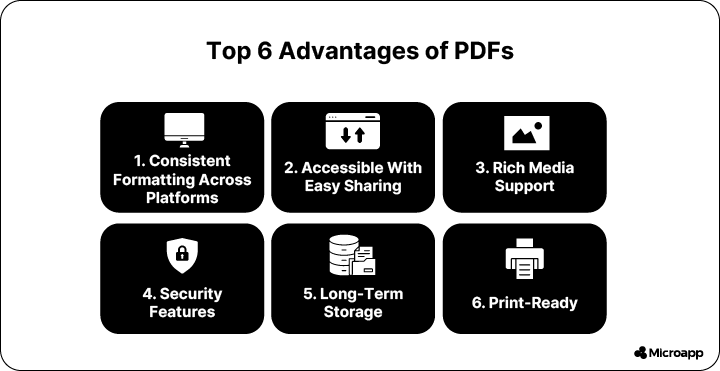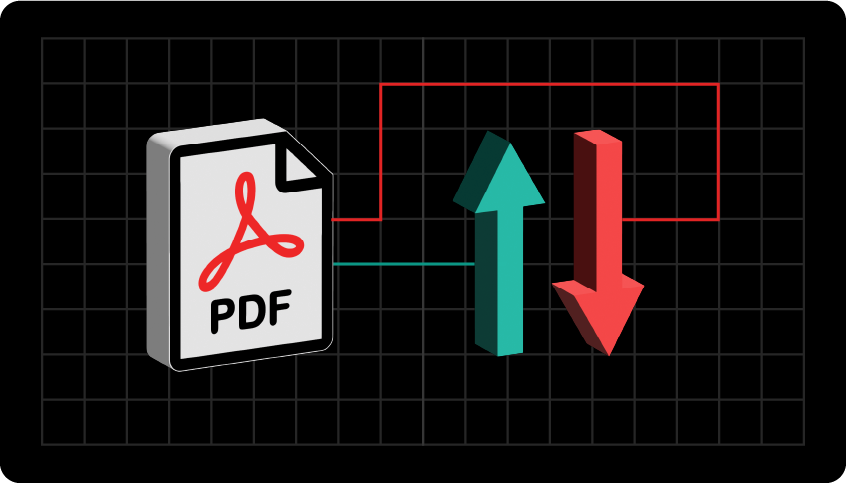In today’s fast-paced digital world, how you share and store documents can significantly impact your workflow.
That’s where the advantages of PDF come in. Unlike Word or Google Docs, PDFs maintain the consistency, professionalism, and security of your files across any device.
But despite their popularity, many people struggle with formatting issues, editing difficulties, or slow conversions.
That’s why we at Microapp have created tools to help you organize, merge, convert, and protect PDFs.
By mastering these advantages, you can work smarter, save time, and ensure every document looks perfect—every time.
What Is a PDF (and Why It’s Still the Standard in 2025)

PDF, short for Portable Document Format, was created by Adobe in the early 1990s to address a simple problem: documents appeared differently on every computer.
PDFs lock in fonts, layouts, images, and graphics, ensuring your document appears exactly as intended, regardless of the device. That’s why PDFs remain the standard for:
- Contracts, proposals, and reports
- Resumes and cover letters
- Manuals, eBooks, and whitepapers
- Forms and printable marketing materials
This versatility makes PDFs indispensable for anyone who values reliability, accessibility, and professional presentation.
Top 10 Advantages of PDF Files

1. Universal Compatibility Across Devices
PDFs are designed to be universally readable. Regardless of whether your recipient is using a Windows PC, Mac, iPhone, Android device, or Linux system, the document appears exactly as intended. Fonts, layouts, and images stay consistent.
💡 Example: Email an invoice or contract to a client anywhere in the world without worrying about how it displays on their device.
👉 Read more on how you can convert your documents to PDF pages.
2. Consistent Formatting and Layout
Unlike editable formats like Word, PDFs lock every visual element. Fonts, headings, tables, charts, and images retain their original design across all devices, ensuring consistency and clarity. This ensures your documents always look polished and professional.
💡 Example: Share a training manual with your team, confident that all graphics, tables, and content appear correctly.
👉Check out how to organize PDFs here.
3. Compact File Size for Easy Sharing
PDFs compress files efficiently without losing quality. Reports, eBooks, or image-heavy documents remain lightweight, making emailing, uploading, and sharing faster and simpler.
💬 Why use PDFs instead of Word?
PDFs retain formatting, are smaller, and are easier to share across devices.
💡 Example: Send a 50-page marketing brochure via email without worrying about attachment limits.
4. Secure and Password-Protected Files
Security is one of the most significant advantages of PDF files. You can encrypt, restrict printing or copying, and add password protection to sensitive documents. This is ideal for financial statements, legal contracts, and confidential proposals.
🔒 Try Microapps Password Protect PDF tool for instant protection. Learn more in our guide: How to Password Protect PDF Files.
5. Supports Multimedia and Interactive Links
Modern PDFs can include images, hyperlinks, embedded videos, and interactive buttons, making them perfect for brochures, e-learning materials, and product catalogs. This transforms static files into interactive experiences that engage your audience.
💡 Example: Embed a product demo video in a PDF brochure or link directly to your website.
6. Long-Term Archiving and Accessibility
With the PDF/A standard, documents remain readable for decades. This is essential for compliance records, legal archives, academic research, and historical documents.
💬 Are PDFs safe for long-term storage?
Yes. PDF/A ensures future accessibility without relying on outdated software.
7. Print-Ready for Professional Results
PDFs are designed for high-quality printing. Fonts, colors, images, and layout are preserved exactly as seen on-screen.
💡 Example: Print resumes, certificates, or marketing materials without worrying about layout shifts or formatting issues.
8. Searchable and Editable (with the Right Tools)
Modern tools allow PDFs to be searchable and editable. OCR (Optical Character Recognition) enables text recognition from scanned documents. The Microapps Organize PDF tool makes editing, rearranging, and updating content easy while preserving the original format.
💡 Example: Quickly locate key terms in a 200-page research report or edit a training manual without losing formatting.
9. Easy Merging and Image Conversion
PDFs make it simple to combine multiple files into a single document. Whether it’s merging reports, compiling feedback, or converting images to PDFs, Microapp tools streamline the process:
- Merge PDFs
- Convert JPG to PDF
💡 Example: Convert multiple JPG images of receipts into a single PDF for expense reporting.
10. Environmentally Friendly & Paperless
Using PDFs reduces the need for printed documents, saving paper, printing costs, and storage space. Digital workflows also expedite approvals, feedback, and collaboration—helping teams work efficiently while minimizing environmental impact.
PDF vs Word / Google Docs
While Word and Google Docs are great for editing, PDFs excel in portability, security, and formatting integrity.
| Feature | Word / Google Docs | |
|---|---|---|
| Formatting | Locked & consistent | Can shift across devices |
| Sharing | Lightweight & universal | May require software compatibility |
| Security | Passwords & encryption | Limited security options |
| Print fidelity | WYSIWYG | Layout may change |
| Archival | Long-term with PDF/A | Not standardized |
💡 Tip: Create your master document in Word or Google Docs, then export as a PDF for distribution and long-term storage.
👉 Learn more about HTML or using PDFs here.
Common Uses of PDFs in Everyday Life

Wondering why we use PDF files so often? Here are practical scenarios:
- Sending professional proposals and invoices
- Sharing forms or applications electronically
- Creating e-books, guides, and whitepapers
- Distributing printable marketing materials
- Archiving contracts, reports, and compliance records
PDFs combine reliability, readability, and portability—a combination few other formats match.
👉 Have you ever wondered why your PDF files are so big? Learn more here.
Disadvantages of PDFs (and How to Overcome Them)
Even with 10 advantages, PDFs have a few limitations:
| Problem | Microapp Solution |
|---|---|
| Hard to edit or rearrange pages | Organize PDF tool |
| Converting web pages is tedious | HTML to PDF tool |
| Merging multiple PDFs is clunky | Merge PDFs tool |
| Image-to-PDF conversions can be messy | Convert JPG to PDF tool |
| Securing PDFs manually is complex | Password Protect PDF tool |
💬 Are there disadvantages to PDFs?
Yes, editing, merging, and converting can be tricky, but Microapp makes these tasks simple and fast.
Tips for Working Smarter With PDFs
- Compress files before sharing to reduce size
- Use cloud storage for collaboration
- Save archival copies in PDF/A format
- Test files on mobile before sending
- Keep a consistent naming system for version control
Master the Power of PDFs
PDFs remain the gold standard for document sharing—thanks to their reliability, portability, and security.
While Adobe pioneered the format, platforms like Microapp make it easier than ever to merge, convert, protect, and organize PDFs with just a few clicks.
So, the next time you’re handling a business contract, invoice, or creative project—remember:
👉 Use PDF files for consistency.
👉 Optimize them with Microapp tools for simplicity.
👉 Work smarter, not harder.








